- News
- Reviews
- Bikes
- Components
- Bar tape & grips
- Bottom brackets
- Brake & gear cables
- Brake & STI levers
- Brake pads & spares
- Brakes
- Cassettes & freewheels
- Chains
- Chainsets & chainrings
- Derailleurs - front
- Derailleurs - rear
- Forks
- Gear levers & shifters
- Groupsets
- Handlebars & extensions
- Headsets
- Hubs
- Inner tubes
- Pedals
- Quick releases & skewers
- Saddles
- Seatposts
- Stems
- Wheels
- Tyres
- Tubeless valves
- Accessories
- Accessories - misc
- Computer mounts
- Bags
- Bar ends
- Bike bags & cases
- Bottle cages
- Bottles
- Cameras
- Car racks
- Child seats
- Computers
- Glasses
- GPS units
- Helmets
- Lights - front
- Lights - rear
- Lights - sets
- Locks
- Mirrors
- Mudguards
- Racks
- Pumps & CO2 inflators
- Puncture kits
- Reflectives
- Smart watches
- Stands and racks
- Trailers
- Clothing
- Health, fitness and nutrition
- Tools and workshop
- Miscellaneous
- Buyers Guides
- Features
- Forum
- Recommends
- Podcast
feature
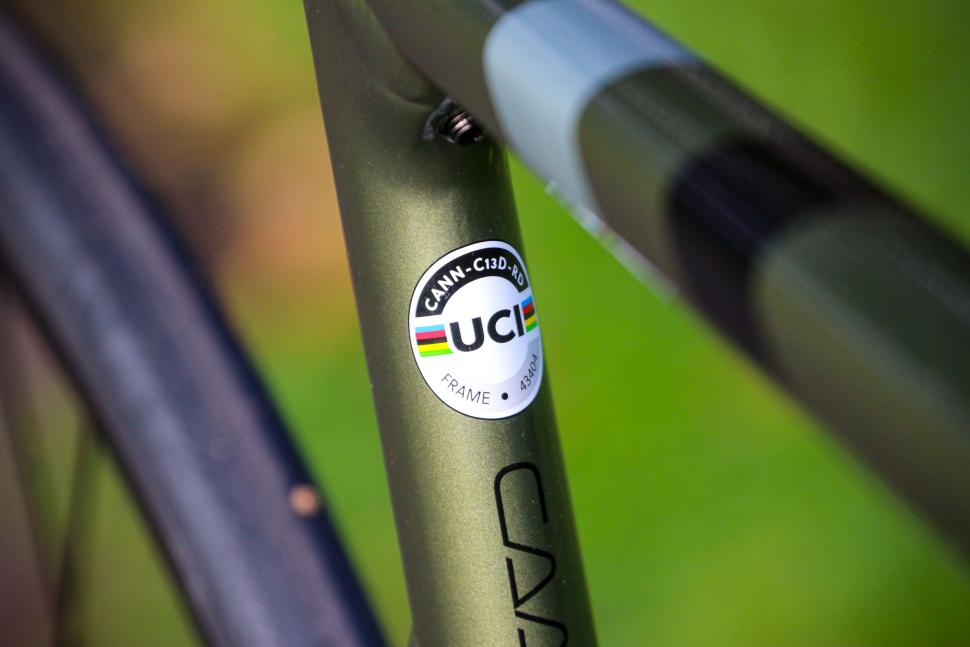 Cannondale CAAD13 Disc 105 - UCI sticker.jpg
Cannondale CAAD13 Disc 105 - UCI sticker.jpgFind out what the UCI-accredited sticker on your bike means
Have you ever looked at the small white UCI logo on your road race bike and wondered why it is there and what it means?
The UCI (Union Cyclist Internationale) is the governing body cycle racing whether it’s road racing, mountain biking or BMX. The organisation has faced many challenges over the years to ensure fair and safe racing, but it is the regulation of equipment that has the biggest impact on you as a consumer of equipment developed for pro racers and sold in your local bike shop.
It has strict rules around what equipment can and can’t be used, the weight of a bicycle, the dimensions that all key parts of a bicycle must fit in, even details like the position of the saddle relative to the bottom bracket. It extends to clothing, sock length and helmets too, but we are mainly focused on the frame and bicycle design in this article.
All technical innovations have needed UCI approval since 2011 when the organisation introduced a new frame and fork approval process. It was met with widespread incredulity but even as soon as one year after its introduction, it was being hailed as a success by the UCI, and today it’s so common on top-end frames that we rarely give it more than a cursory glance.
The UCI says the rules are about rider safety and sporting purity, yet also being a display of technological excellence. Here’s how the UCI defines itself regards policing bicycle design.
“Bicycles and equipment used in competition across the different disciplines are at the forefront of the latest technology. The rules governing the use of equipment aim to ensure both the safety of riders and the fairness of competition while at the same time making the most of the advantages that technological evolution can bring to cycling.
“Bicycles shall comply with the spirit and principle of cycling as a sport. The spirit presupposes that cyclists will compete in competitions on an equal footing. The principle asserts the primacy of man over machine."
The approval process was introduced, the UCI says, to “improve and simplify various aspects of competitive cycling” with benefits including added value to approved equipment, reassurance for riders and customers that a frame can be raced, reduces checks by commissaries at an event and avoid a bike being rejected.
“This approval procedure benefits at the same time the cycling industry, riders, their teams and the commissaries. It is a service provided by the UCI which does not generate any profit. The aim is to guarantee better equity between the riders, informing them which models to choose to be sure that they can take the start of races,” explained the then UCI Technical Coordinator Julien Carron on its introduction.
What does the UCI sticker mean then? It simply means that someone at the organisation has ensured a new bike meets all the necessary technical rules. Once the approval has been granted, the bike brand can apply a sticker to the production bikes and the bike is then listed on the UCI’s database of approved frames.
This list is often where bike media get the first clues that a new bike is coming our way soon, as they’re often listed here months before a new bike is spotted in the real world or launched. I’m sure marketing departments hate this list!
Asked if he thinks the UCI approval process has been a good thing since it was introduced, Specialized's Brand Lead/Integrated Technology Chris Yu reasons that it has reduced the risk of new bikes being banned.
"Generally, yes I think it’s been positive. As much as we like to complain about rules, we know they are a part of competition and anything that makes the application and enforcement of the rules more clear is a benefit in my opinion. Getting prior approval also minimises the risk of introducing something to the market that could potentially be banned after the fact due to a difference in rule interpretation," he explains.
Some say the approval process is really all about preserving the traditional image of a double diamond frame like that introduced with the safety bicycle in 1876 and raced all through the 20th Century. One can only imagine what bicycles we might be riding now if the UCI didn’t wave its rule book at every innovation that has dared to enter the world. They might look a lot more like the iconic Lotus 108 that was swiftly banned by the UCI for being too fast.
Design rules
To get a sense of the challenge facing a bike designer when trying to design a new bike that meets the UCI’s many rules and restrictions, we asked Cannondale Design Engineer Nathan Barry, responsible for the SystemSix and SuperSix Evo, if the UCI approval process is a big factor when designing a bike.
“In short, yes. Anytime we are designing a bike for any kind of road race application we have to consider the implications of the UCI rules. The main ones concern the ‘UCI boxes’. You are probably familiar with these, but they are very prescriptive and more than just the profile depth of certain tubes. To date we have often been restricted in minimum tube size (which was restricted) and in seat stay placement,” he explains.
These so-called 'boxes' as demonstrated in the graphic above, are key when designing a new bike.
“The SystemSix utilises a large proportion of the UCI boxes to maximise the airfoil depth of certain tubes. In doing this it did impose restrictions on things like seat tube, bottom bracket, down tube, fork, head tube design and placement," adds Nathan Barry.
"These boxes are all driven by connections and they float, so in changing the depth of one tube you may restrict material available on another. So frequently you need to compromise trade-offs between certain elements to work within these constraints.”
It's worth stating that the UCI approval process only applies to bikes that are going to be raced in events overseen by the UCI. Many bikes fall outside of this like Cannondale's Topstone Carbon, a gravel and adventure bike which will never be raced in the peloton.
“The new Topstone has very low seat stay, which is important to get the whole system to flex naturally. This is something we couldn’t pull off in the same way for a UCI stickered bike because there is a limit to how low you can mount the seat stay,” explains Nathan when asked about the different challenges of designing a bike free from the UCI rules.
The approval process requires a bike company to send approval requests before June 30th of any year and if accepted will be permitted from January 1st the following year. The UCI requires technical drawings to be submitted with the UCI needed three months to check them. This is then followed by checking sample products after the production of the prototypes. Here’s the approval procedure:
A sticker is then issued. It centres around the UCI logo with a code identifying the model and approval data. There are even rules for the position of the sticker on the frame. No hiding it under the bottom bracket! “The label must be visible, indelible and inseparable from the frame,” says the UCI and for most frame manufacturers, that means the seat tube.
It sounds like designing a bike to meet all these rules and get the UCI approval would be a huge challenge then, but Specialized's Chris Yu says there is a conversation between designer and rule-maker that helps in the process of designing a new bike.
"I wouldn’t say it’s a big challenge nor is it easy, at least if you are designing right at the limit of what’s permissible. But the approval process now allows for a dialogue and certainty before we commit to producing something," he says.
If you’re bored at work, why not have a read of the UCI’s approval protocol document?
The costs
Is it simply a revenue generator for the organisation? “It is a service provided by the UCI which does not generate any profit,” said the UCI at its launch, with payment only to cover the costs generated by the approval process.
When it was first announced, the £8,000 figure caused headlines with accusations it was plucked out of the air. The price was quickly reduced.
Today, the maximum cost for each model of frame and fork for a maximum of eight sizes costs CHF 5,000, or £3,860 at the current exchange rate. This needs to be paid within 30 days of invoicing for each submission of a new model.
I think it’s fair to say the UCI sticker is of little interest to consumers, it doesn’t add any value to a frame and people aren’t basing their buying decision on whether a bike is UCI approved or not. Have you ever bought a frame because it had a UCI sticker?
Summary
Has the UCI approval process been a positive or negative thing for the cycling world and industry? It has certainly brought sporting parity to the sport by ensuring that all frames used in the professional peloton adhere to the same design rules, and we don't see bikes being banned on the start line like we used to, but it has restricted design freedom and resulted in many top-end road race bikes looking very similar.
Proving that the rules are still open to interpretation is the recently unveiled Lotus/Hope track bike developed for British Cycling to race at the Tokyo 2020 Olympics. It’s a bike that pushes the envelope more than any we’ve seen in recent years. Despite its radical appearance, it adheres to the UCI rules, has a sticker on the frame and can be bought for £15k, and speaking to British Cycling and Hope recently revealed that the UCI was involved throughout the development and it passed inspection at the first track race it was ridden at.
So there is still clearly scope for pushing the boundaries within the rules. What if there were no rules, or you could scrap one set of rules? We asked Specialized's Chris Yu if there was one rule he could change in the UCI rule book when designing his next road bike, what would it be?
"That’s like asking a parent who their favorite (least favorite?) child is. There’s quite a few so I’m not sure we’d be able to point out any single thing as the silver bullet. Generally, I’m a fan of simplification of the rules and I think there’s a lot of opportunity to do that within the current definitions," he says.
Now you know just what the UCI sticker on your bike means and what is involved for the bike company. Now it's over to you, we want to know if the UCI sticker influences your decision when buying a new road bike?
David worked on the road.cc tech team from 2012-2020. Previously he was editor of Bikemagic.com and before that staff writer at RCUK. He's a seasoned cyclist of all disciplines, from road to mountain biking, touring to cyclo-cross, he only wishes he had time to ride them all. He's mildly competitive, though he'll never admit it, and is a frequent road racer but is too lazy to do really well. He currently resides in the Cotswolds, and you can now find him over on his own YouTube channel David Arthur - Just Ride Bikes.
Latest Comments
- hawkinspeter 4 sec ago
I've got a Nitecore EBP10 mini pump which is a very similar (though better) than the MucOff one (approx £60):...
- chrisonabike 9 min 5 sec ago
Silly of them to put the wall back there again. Couldn't they take a hint?
- hawkinspeter 12 min 31 sec ago
Another vote for Bont, here. I bought a new pair of wide-fitting Bont Riot G MTB shoes this year and they're perfect.
- RobD 18 min 21 sec ago
It's a real shame, his bikes seem incredible, I've dreamt of owning one for a long time. Really sad that he's had customers let him down repeatedly...
- David9694 1 hour 15 min ago
Driver Who Broke Runner's Spine in Three Places Praised for Waiting Around Until Help Arrived
- Steve K 1 hour 52 min ago
Even if this gets to 100,000 signatures, I suspect the Petitions Committee will simply say there has already been a debate, so no need for another...
- mdavidford 10 hours 31 min ago
Obviously it means 'springing out of the bunch' on a critical sector. Or maybe it's referring to the time of year.
- David9694 11 hours 20 min ago
Woman taken to hospital after flipping car onto roof in Trowbridge...
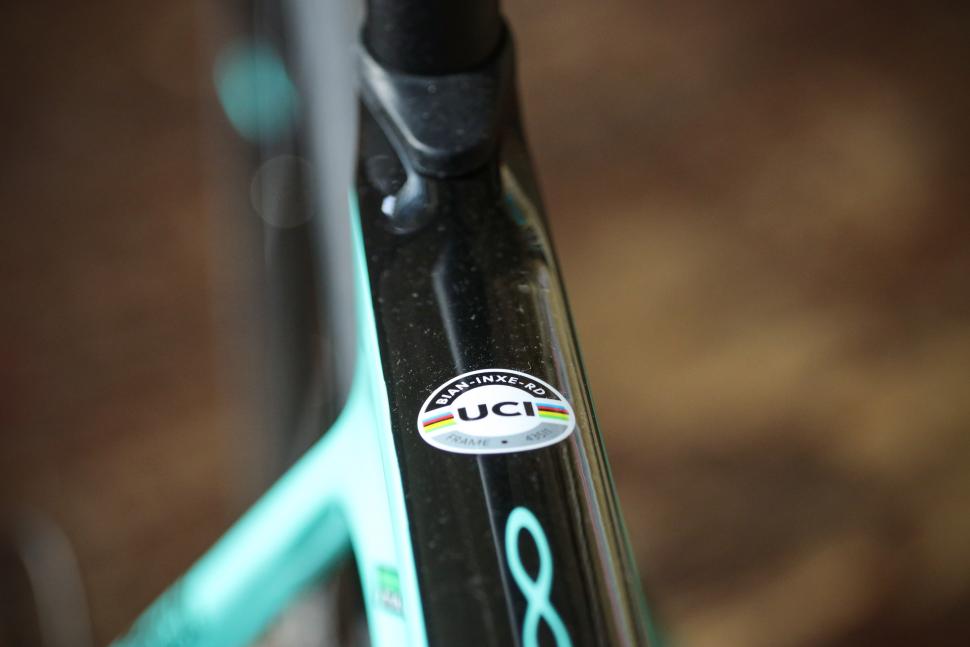

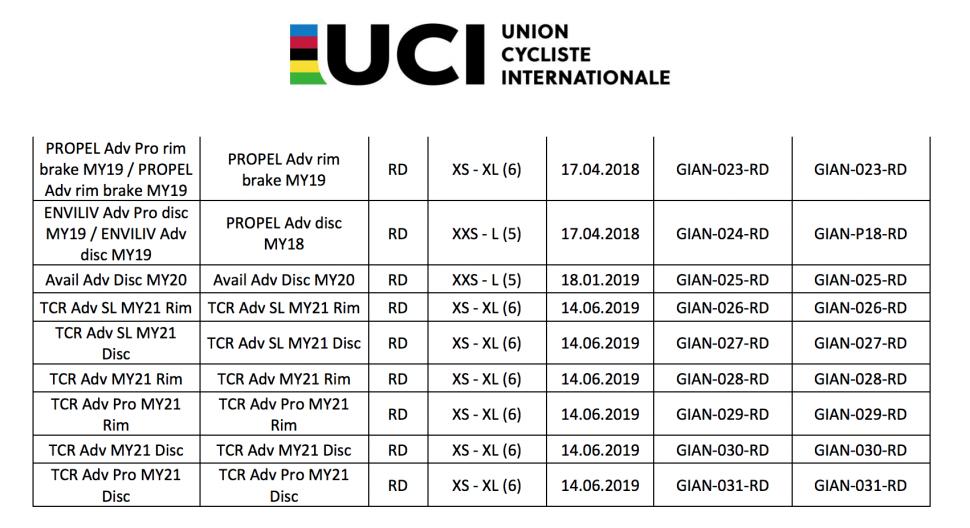


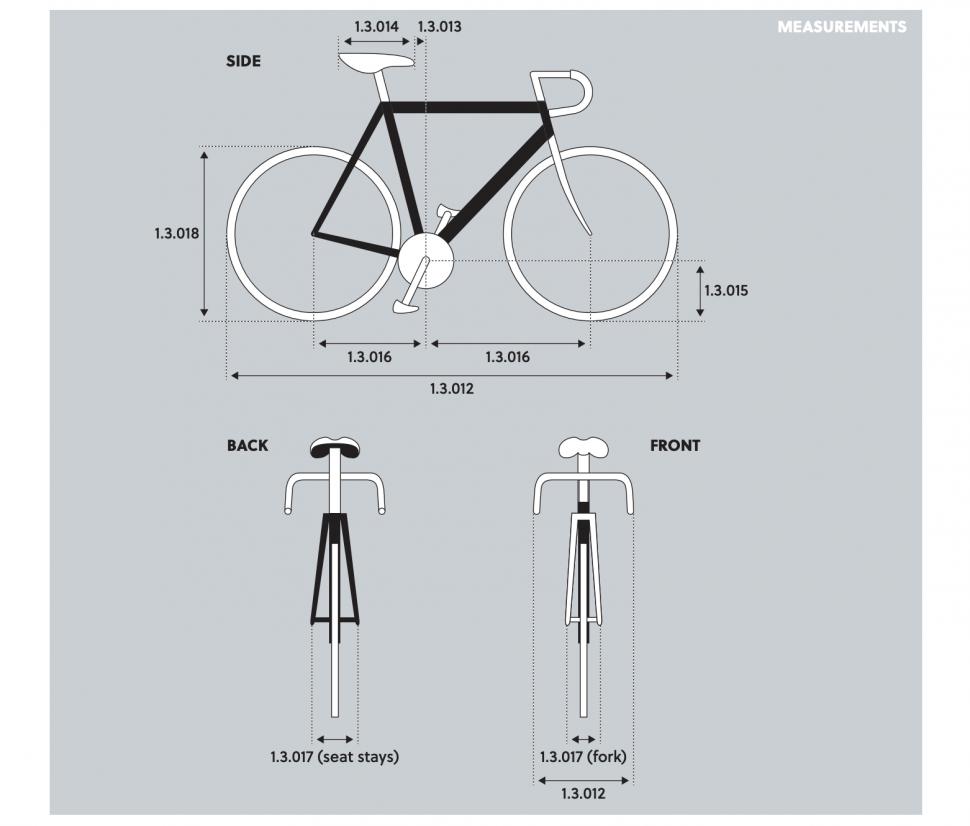

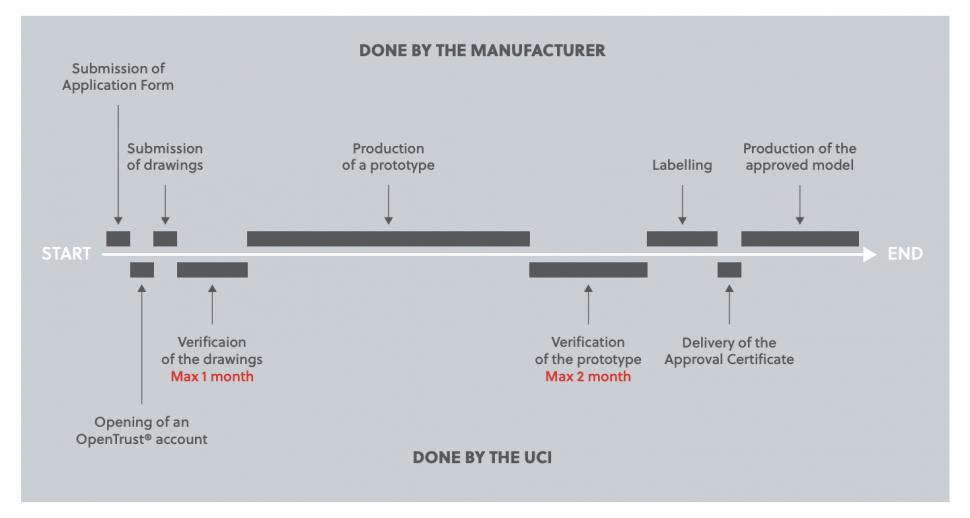


Add new comment
6 comments
Unless you're racing who cares? The ludicrous 6.8kg weight minimum is so out of date it completely stifles innovation. It obviously helps manufacturers who have heavy disc brake bikes to punt out, but does nothing for people who actually pay for their own bikes.
Meanwhile the industry scratches its own back and sells £10k bikes that all look the same.
"Many bikes fall outside of this like Cannondale's Topstone Carbon, a gravel and adventure bike which will never be raced in the peloton."
The UCI is turning its attention to gravel racing too. As with technology, they're a couple of years behind the curve, but they'll get there.
Look have already got UCI certification for their 765 Gravel bike.
couple of hours 'work' for best part of £4k, yeah, no profiting from that whatsoever, also rules for safety hahahahaha, that's another good one!
if the companies already know the rules then they shouldn't need UCI approval stickers to meet the regs in competition that UCI rule the roost over, just that the frames meet the spec surely? Elsewhere as mentiond it's pretty much worthless and looks a bit naff, a bit like the 'world champion' stickers they used to put on gas pipe steel frames BITD to help sell them.
Did you actually read a the article? Just because Bike Company X thinks something is "legal", it doesn't mean the UCI will be of the same opinion when it turns up at the start line of a race. This process avoids that problem.
It means you've paid thousands of Euros to have them look at one frame and read your geometry chart to ensure that it passes their shaping regulations.
It means.... that if your not wearing the correct length socks then the UCI pay people to stand at the side of the road hurling abuse at you for giving cycling a bad name.